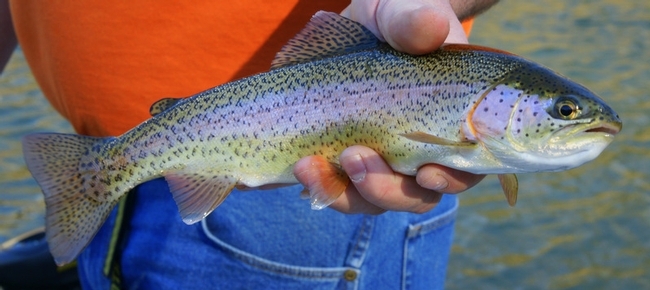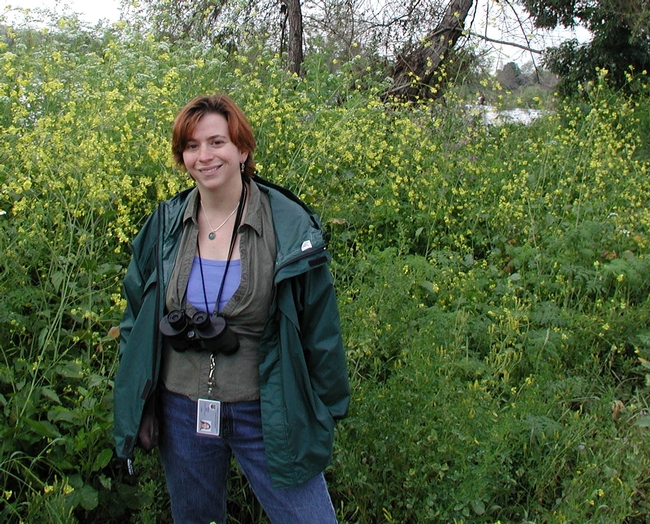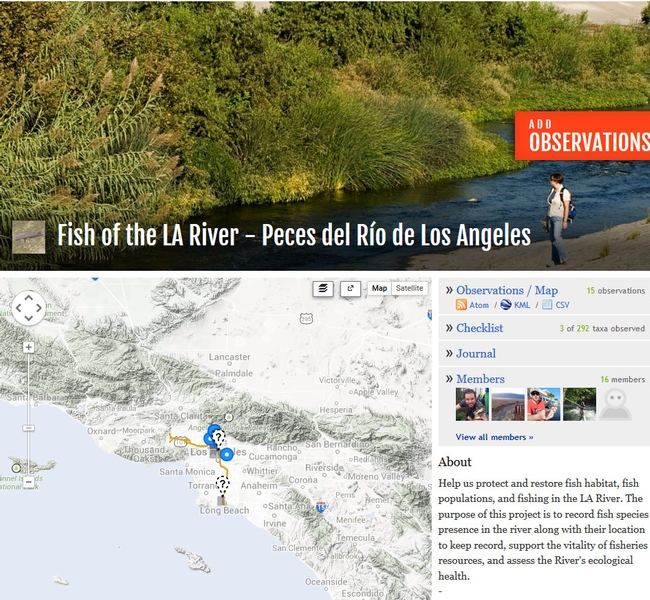Posts Tagged: Los Angeles
Painted Ladies on the Move
The painted ladies are on the move. Have you seen these migratory butterflies, Vanessa cardui, passing through California on their way to the...
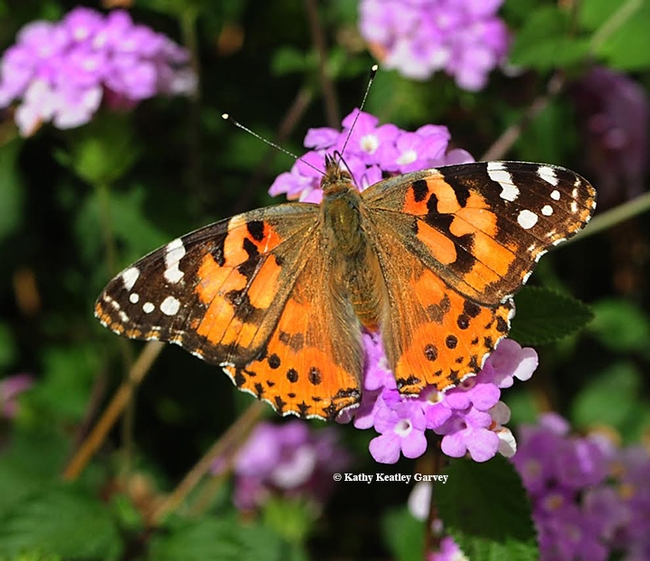
A painted lady, Vanessa cardui, photographed on lantana in Vacaville in 2015. (Photo by Kathy Keatley Garvey)
LA's concrete river revitalization unlikey to create habitat for steelhead trout
The city of Los Angeles is preparing to remove parts of the LA River's concrete lining, but that may not be enough to bring back native fish, reported Zoie Matthew in Los Angeles Magazine.
"It's hard to do piece-by-piece restoration projects for things adapted to river and stream systems. And it's impossible for steelhead," said Sabrina Drill, UC Cooperative Extension natural resources advisor in Los Angeles and Ventura counties.
Steelhead need a continuous, rapidly flowing channel to complete their life cycle. Other native fish, such as the Arroyo chub, will need gravel, plants, sediment and pools to be restored.
"Ecological heterogeneity is really important," Drill said. "Fish tend to need different kinds of habitat."
Warmer water temperature is another concern. The river lacks trees and plants to shade the water and concrete soaks up the sun's warmth, creating a habitat unsuitable for natives.
Drill said some of the new fish in the river have favorable characteristics. Mosquito fish help with pest control and carp make for good fishing.
"Part of (the river's) role is to provide low-income, underserved communities with a place to access nature, see native birds, and increase public health by having a safe area to walk and fish," Drill said. "I think there's value there too."
Heavy rains this winter may help native fish in the LA River make a comeback
Biologists believe a high volume of water flowing through the Los Angeles River this winter due to El Niño rain will favor native fish, reported Louis Sahagun in the Los Angeles Times. Native species - who evolved in river systems prone to sudden torrents of water, mud, bolders and debris in winter and pools and damp patches in summer - main gain an edge when the river rages.
Currently, the fish population in the river is almost entirely non-native. Released as bait by anglers, dumped by the city to eat unwelcome species, and aquarium fish set free by their owners now populate the river's waters.
The forecast heavy rains during the 2015-16 winter present an opportunity to determine whether nonnative fish will be washed out of the river and into the Pacific Ocean, giving native fish a new chance to become established.
"If we are ever going to fully understand the ecology of this river, and prospects for the return of species that evolved in it, we have to know first what's in it now, and how well those creatures do in extreme conditions," said biologist Rosi Dagit of the Resource Conservation District.
UC Cooperative Extension natural resources advisor Sabrina Drill was among a group of biologists and volunteers who surveyed the fish in the river in late November with seines, dip nets and rods and reels. After six hours, the team caught about 3,000 talapia, two dozen crayfish, a few hundred mosquito fish, one aquarium species and two Asian freshwater clams.
The research is funded by the Friends of the Los Angeles River.
The Hitchhiker
Oleander aphids, those cartoonish-looking yellow insects with black legs and cornicles, are commonly found on oleanders. Hence their name. But they...
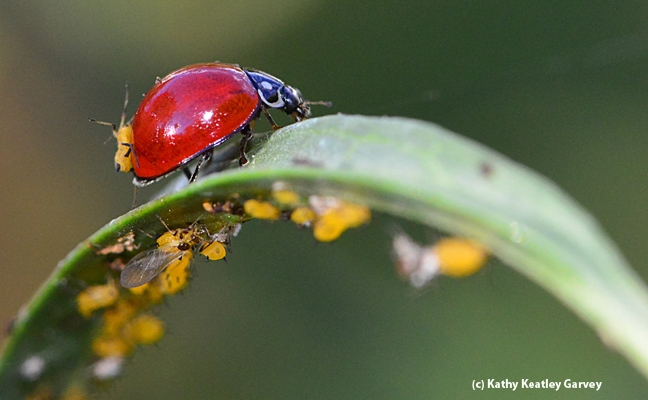
A lady beetle picks up a hitchhiker, an oleander aphid. (Photo by Kathy Keatley Garvey)
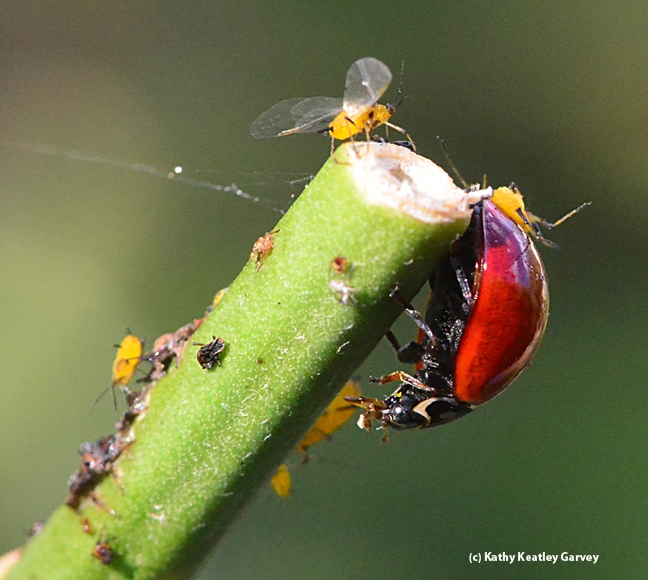
One on the back and one in the mouth. (Photo by Kathy Keatley Garvey)
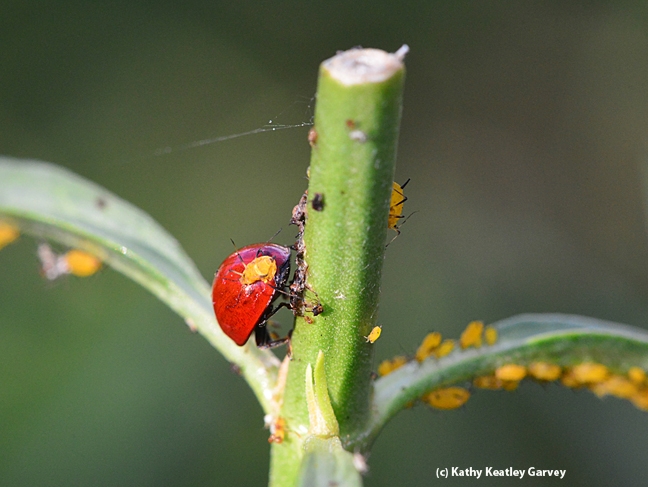
The oleander aphid maintains its hold on the back of its predator, a lady beetle. (Photo by Kathy Keatley Garvey)
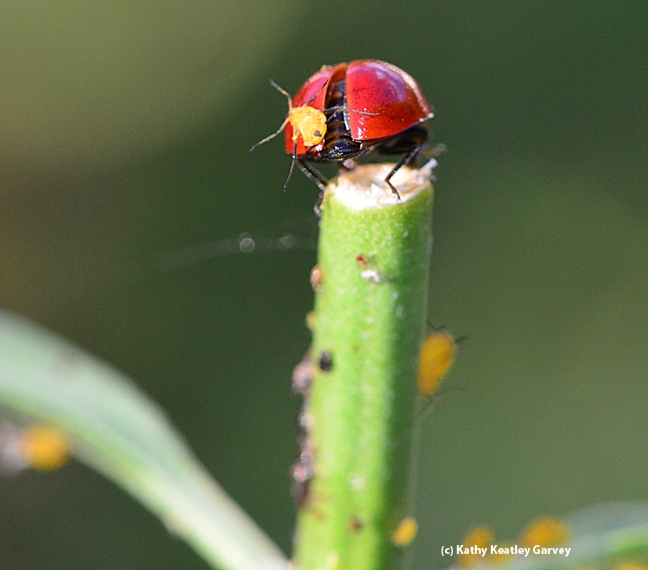
The lady beetle prepares for take-off, with the oleander aphid still clinging to its back. (Photo by Kathy Keatley Garvey)
Citizen science in the L.A. River expanding
The Friends of the Los Angeles River organization is expanding its citizen science monitoring of fish in the Los Angeles River to additional locations, reported Carren Jao in KCET Columns.
Since 2008, the volunteers have been catching fish in Elysian Valley of the L.A. River and delivering them for analysis to three biologists, including Sabrina Drill, UC Agriculture and Natural Resources Cooperative Extension advisor in Los Angeles County. The biologists found that the fish caught here were healthier and lower in mercury and PCBs than fish in the ocean. The surprising finding is likely due to the natural river bottom in the Glendale Narrows portion of the river.
Now volunteers will be turning their attention to parts of the L.A. River in Long Beach and the Sepulveda Basin to establish a baseline for those areas.
Citizen scientists can also help document the state of the L.A. River by contributing to a project created by UC ANR's Sabrina Drill on the web and smartphone app iNaturalist. Anglers can take a smartphone photo of their L.A. River catch and upload it to iNaturalist. The smartphone automatically records the time and day, and the GPS coordinates where the fish was caught. Much like iNaturalist does for birds, lizards, and insects, the L.A. River fish page creates a digital community where fishermen can boast of their accomplishments, but also build a record of the river's biodiversity using their smartphones.


